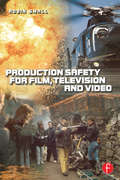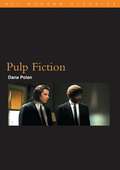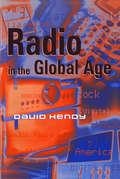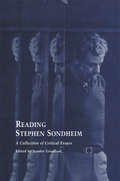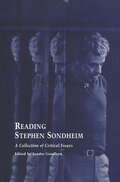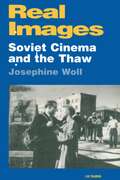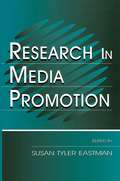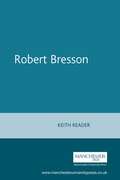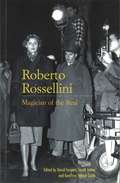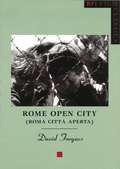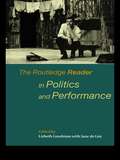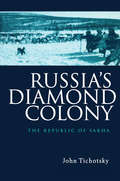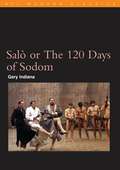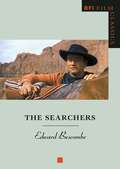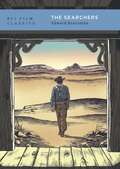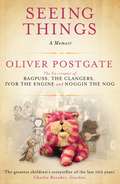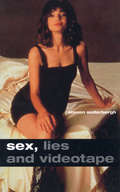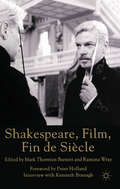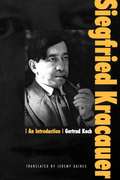- Table View
- List View
Production Safety for Film, Television and Video
by Robin SmallCovering all aspects of production safety, this is an invaluable reference guide for the independent programme maker, freelancer, manager, producer, tutor and student filmmaker. Robin Small identifies all the major risks and gives advice on how to control and/or eliminate them. Each hazard section includes useful references to the relevant legislation, documents and licences, as well as addresses of organisations for essential advice and recommended further reading. An appendix lists samples of vital certificates, with visual references provided on www.focalpress.com. Important information about hazard identification, risk assessment and safety policy is provided in the chapters covering legislation, health and safety management, personal protective equipment and insurance. Particular hazards are then split into individual sections for ease of reference. These hazards include:AsbestosCranesExplosives and pyrotechnicsFood and cateringManual handing and liftingVisual display screensWorking at heightsThe appendices provide comprehensive contact information for UK and European Heath and Safety sources. They also include sample forms to draw up your own safety system.Robin Small is Senior Lecturer in Television, Media Department at the University of Huddersfield.
Production Safety for Film, Television and Video
by Robin SmallCovering all aspects of production safety, this is an invaluable reference guide for the independent programme maker, freelancer, manager, producer, tutor and student filmmaker. Robin Small identifies all the major risks and gives advice on how to control and/or eliminate them. Each hazard section includes useful references to the relevant legislation, documents and licences, as well as addresses of organisations for essential advice and recommended further reading. An appendix lists samples of vital certificates, with visual references provided on www.focalpress.com. Important information about hazard identification, risk assessment and safety policy is provided in the chapters covering legislation, health and safety management, personal protective equipment and insurance. Particular hazards are then split into individual sections for ease of reference. These hazards include:AsbestosCranesExplosives and pyrotechnicsFood and cateringManual handing and liftingVisual display screensWorking at heightsThe appendices provide comprehensive contact information for UK and European Heath and Safety sources. They also include sample forms to draw up your own safety system.Robin Small is Senior Lecturer in Television, Media Department at the University of Huddersfield.
Pulp Fiction (BFI Film Classics)
by Dana PolanDana Polan sets out to unlock the style and technique of 'Pulp Fiction'. He shows how broad Tarantino's points of reference are, and analyzes the narrative accomplishment and complexity. In addition, Polan argues that macho attitudes celebrated in film are much more complex than they seem.
Radio in the Global Age
by David HendyRadio in the Global Age offers a fresh, up-to-date, and wide-ranging introduction to the role of radio in contemporary society. It places radio, for the first time, in a global context, and pays special attention to the impact of the Internet, digitalization and globalization on the political-economy of radio. It also provides a new emphasis on the links between music and radio, the impact of formatting, and the broader cultural roles the medium plays in constructing identities and nurturing musical tastes. Individual chapters explore the changing structures of the radio industry, the way programmes are produced, the act of listening and the construction of audiences, the different meanings attached to programmes, and the cultural impact of radio across the globe. David Hendy portrays a medium of extraordinary contradictions: a cheap and accessible means of communication, but also one increasingly dominated by rigid formats and multinational companies; a highly 'intimate' medium, but one capable of building large communities of listeners scattered across huge spaces; a force for nourishing regional identity, but also a pervasive broadcaster of globalized music products; a 'stimulus to the imagination', but a purveyor of the banal and of the routine. Drawing on recent research from as far afield as Africa, Australasia and Latin America, as well as from the UK and US, the book aims to explore and to explain these paradoxes - and, in the process, to offer an imaginative reworking of Marshall McLuhan's famous dictum that radio is one of the world's 'hot' media. Radio in the Global Age is an invaluable text for undergraduates and researchers in media studies, communication studies, journalism, cultural studies, and musicology. It will also be of interest to practitioners and policy-makers in the radio industry.
Radio in the Global Age
by David HendyRadio in the Global Age offers a fresh, up-to-date, and wide-ranging introduction to the role of radio in contemporary society. It places radio, for the first time, in a global context, and pays special attention to the impact of the Internet, digitalization and globalization on the political-economy of radio. It also provides a new emphasis on the links between music and radio, the impact of formatting, and the broader cultural roles the medium plays in constructing identities and nurturing musical tastes. Individual chapters explore the changing structures of the radio industry, the way programmes are produced, the act of listening and the construction of audiences, the different meanings attached to programmes, and the cultural impact of radio across the globe. David Hendy portrays a medium of extraordinary contradictions: a cheap and accessible means of communication, but also one increasingly dominated by rigid formats and multinational companies; a highly 'intimate' medium, but one capable of building large communities of listeners scattered across huge spaces; a force for nourishing regional identity, but also a pervasive broadcaster of globalized music products; a 'stimulus to the imagination', but a purveyor of the banal and of the routine. Drawing on recent research from as far afield as Africa, Australasia and Latin America, as well as from the UK and US, the book aims to explore and to explain these paradoxes - and, in the process, to offer an imaginative reworking of Marshall McLuhan's famous dictum that radio is one of the world's 'hot' media. Radio in the Global Age is an invaluable text for undergraduates and researchers in media studies, communication studies, journalism, cultural studies, and musicology. It will also be of interest to practitioners and policy-makers in the radio industry.
Reading Stephen Sondheim: A Collection of Critical Essays (Studies in Modern Drama)
by Sandor GoodhartFirst Published in 2000. Routledge is an imprint of Taylor & Francis, an informa company.
Reading Stephen Sondheim: A Collection of Critical Essays (Studies in Modern Drama #Vol. 10)
by Sandor GoodhartFirst Published in 2000. Routledge is an imprint of Taylor & Francis, an informa company.
Real Images: Soviet Cinema and the Thaw (KINO - The Russian and Soviet Cinema)
by Josephine WollDuring ""the thaw"" from Stalin's death in 1953 to the late 1960s and Khrushchev's rule, Soviet society experienced major transformations. So did films. In this first comprehensive account of the relationship between politics and cinema in this period, Josephine Woll skillfully interweaves cultural history with film analysis to explore how movies at once responded to the changes around them and helped engender them. She considers dozens of individual films within the context of Khrushchev's policies and the artistic foment they inspired.
Research in Media Promotion (Routledge Communication Series)
by Susan Tyler EastmanEastman has assembled this exemplary volume to spotlight media promotion and to examine current research on the promotion of television and radio programs. The studies included here explore various types of promotion and use widely differing methods and approaches, providing a comprehensive overview of promotion research activities. Chapters include extensive literature reviews, original research, and discussion of research questions for subsequent study. Research in Media Promotion serves as a benchmark for the current state of promotion research and theory, and establishes the role of promotion as a primary factor affecting audience size. Appropriate for coursework and study in programming, marketing, research methods, management, and industry processes and practices, this volume offers agenda items for future study and is certain to stimulate new research ideas.
Research in Media Promotion (Routledge Communication Series)
by Susan Tyler EastmanEastman has assembled this exemplary volume to spotlight media promotion and to examine current research on the promotion of television and radio programs. The studies included here explore various types of promotion and use widely differing methods and approaches, providing a comprehensive overview of promotion research activities. Chapters include extensive literature reviews, original research, and discussion of research questions for subsequent study. Research in Media Promotion serves as a benchmark for the current state of promotion research and theory, and establishes the role of promotion as a primary factor affecting audience size. Appropriate for coursework and study in programming, marketing, research methods, management, and industry processes and practices, this volume offers agenda items for future study and is certain to stimulate new research ideas.
Robert Bresson (French Film Directors Series)
by Keith ReaderThis book provides a comprehensive introduction to the work of Robert Bresson, one of the most respected and acclaimed directors in the history of cinema.. The first monograph on his work to appear in English for many years dealing not only with his thirteen feature-length films but also his little-seen early short Affaires publiques and his short treatise Notes on cinematography.. The films are considered in chronological order, using a perspective that draws variously on spectator theory, Catholic mysticism, gender theory and Lacanian psychoanalysis.. The major critical responses to his work, from the adulatory to the dismissive, are summarized and analyzed.. The work includes a full filmography and a critical bibliography.
Roberto Rossellini: Magician of the Real
by David Forgacs Sarah Lutton Geoffrey Nowell-SmithA master of modern European cinema and a key figure in the Italian neorealist movement, Roberto Rossellini had one of the longest and most varied careers of all major directors. From 'Rome Open City' and 'Paisà ' through to the 'Bergman' classics 'Stromboli 'and 'Journey to Italy' and his later work for television, Rossellini's work and ideas had a profound influence on filmmaking and criticism. This specially commissioned overview of Rossellini's works examines key issues and themes covering all phases of his career. Leading critics from across the world examine, among other issues, the Fascist context of Rossellini's early work, the view of Europe that emerges in his films, the stylistic trajectory of the work through neorealism and beyond and its influence on the French New Wave, the issues of representation that emerge in later films and his extensive work for television. The significance of Rossellini's relationships with Ingrid Bergman and Anna Magnani is discussed and the book also includes a dossier section of materials providing an overview of the most important facts and documents concerning the director.
Rome Open City: ( Roma Citta Aperta ) (BFI Film Classics)
by David ForgacsOtto Preminger said the history of the cinema was divided into two eras: one before and one after Rome Open City (Roma Città Aperta, 1945). The film is based on events that took place in Rome in 1944, during the Nazi occupation. This book re-examines the film and its place in Rossellini's career. David Forgacs reconstructs its production history, its relationship to the events that inspired it and the time in which it was made. He argues that the traditional critical labelling of Rome Open City as the original work of neo-realism fails to capture the film's hybrid and contradictory character. Part documentary record, part patriotic myth, Rome Open City is at once an extraordinarily powerful commemoration of wartime experience and a rhetorical reworking of that experience, using stereotypes and moral polarisations.
The Routledge Reader in Politics and Performance
by Jane De Gay Lizbeth GoodmanThe Routledge Reader in Politics and Performance brings together for the first time a comprehensive collection of extracts from key writings on politics, ideology, and performance. Taking an interdisciplinary approach to the subject, and including new writings from leading scholars, the book provides material on: * post-coloniality and performance theory and practice * critical theories and performance * intercultural perspectives * power, politics and the theatre * sexuality in performance * live arts and the media * theatre games.
The Routledge Reader in Politics and Performance
by Jane De Gay Lizbeth GoodmanThe Routledge Reader in Politics and Performance brings together for the first time a comprehensive collection of extracts from key writings on politics, ideology, and performance. Taking an interdisciplinary approach to the subject, and including new writings from leading scholars, the book provides material on: * post-coloniality and performance theory and practice * critical theories and performance * intercultural perspectives * power, politics and the theatre * sexuality in performance * live arts and the media * theatre games.
Russia's Diamond Colony: The Republic of Sakha
by John TichotskyFirst Published in 2000. Routledge is an imprint of Taylor & Francis, an informa company.
Russia's Diamond Colony: The Republic of Sakha
by John TichotskyFirst Published in 2000. Routledge is an imprint of Taylor & Francis, an informa company.
Salo (BFI Film Classics)
by Gary IndianaBeneath the extreme, taboo-breaking surface of 'Salo' (a controversial and scandalous film made in 1975), Gary Indiana argues that there's a deeply penetrating account of human behaviour which resonates as an account of fascism and as a picture of the corporate world we live in. 'Salo' was Pier Pasolini's last film (he was murdered shortly after completing it). An adaptation of Sade's vicious masterpiece, it is an unflinching, violent portrayal of sexual cruelty which many find too disturbing to watch.
The Searchers (BFI Film Classics)
by Edward BuscombeJohn Ford's masterpiece The Searchers (1956) was rated fifth greatest film of all time in Sight and Sound's most recent poll of critics. Its influence on many of America's most distinguished contemporary filmmakers, among them Martin Scorsese, Paul Schrader, and John Milius, is enormous. John Wayne's portrait of the vengeful Confederate Ethan Edwards gives the film a truly epic dimension, as his long and lonely journey into the dark heart of America. Edward Buscombe provides a detailed commentary on all aspects of the film, and makes full use of material in the John Ford archive at Indiana University, including Ford's own memos and the original script, which differs in vital respects from the film he made.
The Searchers (BFI Film Classics)
by Edward BuscombeJohn Ford's masterpiece The Searchers (1956) was voted the seventh greatest film of all time in Sight & Sound's most recent poll of critics. Its influence on many of America's most distinguished contemporary filmmakers, among them Martin Scorsese, Paul Schrader, and John Milius, is enormous. John Wayne's portrait of the vengeful Confederate Ethan Edwards gives the film a truly epic dimension, as does his long and lonely journey into the dark heart of America. Edward Buscombe's insightful study provides a detailed commentary on all aspects of the film, drawing on material in the John Ford archive at Indiana University, including Ford's own memos and the original script, which differs in vital respects from the film he made, to offer new insights into the film's production history.
Seeing Things: A Memoir
by Oliver PostgateOliver Postgate is widely regarded as the greatest children's storyteller of the modern era. His work, which included The Clangers, Ivor the Engine, The Pogles, Noggin the Nog and, most famously, Bagpuss, is beloved by generations. In this delicious memoir Oliver Postgate describes how he came to create his stories and characters, developing innovative techniques of animation and puppetry alongside his friend and co-producer Peter Firmin. Amazingly, almost all of Oliver's films were made in a cowshed in Kent on a budget of next to nothing. The story of Oliver Postgate's extraordinary and adventurous life, and the wonderful characters who populated it - both real and imagined - is witty, charming, beautifully remembered and exquisitely told.
sex, lies and videotape (Faber Reel Classics Ser.)
by Steven SoderberghLike Michael Powell's Peeping Tom, Steven Soderbergh's sex, lies and videotape presents us with a protagonist who can only connect with others through the lens of a camera. Graham is an enigmatic young man who returns to Baton Rouge from a long road trip, mildly irritating his old lawyer friend John and wholly intriguing John's housebound wife Ann. John is conducting a sneaky and entirely sexual affair with Ann's sister Cynthia. For her part, Ann has lost interest in sex, yet Graham's obscurely charming eccentricity stirs something inside her - until she learns that he is functionally impotent and can manage arousal only with the help of a video camera and an agreeably loose-lipped female. Nevertheless, it's the dragging into the open of Graham's dirty little secret that causes all of these characters to confront their own veiled deceits and hypocrisies.sex, lies and videotape won the Palme d'Or at the 1989 Cannes Film Festival, affirming the arrival of a distinctive new talent and signalling the start of a movement among young independent American film-makers opposed to the values and formats of the Hollywood system. Soderbergh's script is an unerringly elegant, witty and literate study of contemporary perversity.
Shakespeare, Film, Fin de Siecle
by Mark Thornton Burnett Ramona WrayThe essays in this volume read the Shakespeare films of the 1990s as key instruments with which western culture confronts the anxieties attendant upon the transition from one century to another. Such films as Hamlet, Love's Labour's Lost, Othello, Shakespeare in Love and William Shakespeare's Romeo and Juliet , the contributors maintain, engage with some of the most pressing concerns of the present, apocalyptic condition - familial crisis, social estrangement, urban blight, cultural hybridity, literary authority, the impact of technology and the end of history. The volume includes an exclusive interview with Kenneth Branagh.
Siegfried Kracauer: An Introduction
by Gertrud Koch Jeremy GainesSiegfried Kracauer has been misunderstood as a naïve realist, appreciated as an astute critic of early German film, and noticed as the interesting exile who exchanged letters with Erwin Panofsky. But he is most widely thought of as the odd uncle of famed Frankfurt School critical theorists Jürgen Habermas, Theodor Adorno, Walter Benjamin, and Max Horkheimer. Recently, however, scholars have rediscovered in Kracauer's writings a philosopher, sociologist, and film theorist important beyond his associations--and perhaps one of the most significant cultural critics of the twentieth century. Gertrud Koch advances this Kracauer renaissance with the first-ever critical assessment of his entire body of work. Koch's analysis, which is concise without sacrificing thoroughness or sophistication, covers both Kracauer's best-known publications (e.g., From Caligari to Hitler, in which he gleans the roots of National Socialism in the films of the Weimar Republic) and previously underexamined texts, including two newly discovered autobiographical novels. Because Kracauer's wide-ranging works emerge from no rigidly unified approach, instead always remaining open to unusual and highly individual perspectives, Koch resists the temptation to force generalization. She does, however, identify recurring tropes in Kracauer's lifetime effort to perceive the basic posture and composition of particular cultures through their visual surfaces. Koch also finds in Kracauer a surprisingly contemporary cultural commentator, whose ideas speak directly to current discussions on film, urban modernity, feminism, cultural representation, violence, and other themes. This book was long-awaited in Germany, as well as widely and well reviewed. Now translated into English for the first time, it will fuel already growing interest in the United States, where Kracauer lived and wrote from 1941 until his death in 1966. It will attract the attention of students and scholars working in Film Studies, German Studies, Comparative Literature, Critical Theory, Cultural Studies, Philosophy, and History.
Siegfried Kracauer: An Introduction
by Gertrud Koch Jeremy GainesSiegfried Kracauer has been misunderstood as a naïve realist, appreciated as an astute critic of early German film, and noticed as the interesting exile who exchanged letters with Erwin Panofsky. But he is most widely thought of as the odd uncle of famed Frankfurt School critical theorists Jürgen Habermas, Theodor Adorno, Walter Benjamin, and Max Horkheimer. Recently, however, scholars have rediscovered in Kracauer's writings a philosopher, sociologist, and film theorist important beyond his associations--and perhaps one of the most significant cultural critics of the twentieth century. Gertrud Koch advances this Kracauer renaissance with the first-ever critical assessment of his entire body of work. Koch's analysis, which is concise without sacrificing thoroughness or sophistication, covers both Kracauer's best-known publications (e.g., From Caligari to Hitler, in which he gleans the roots of National Socialism in the films of the Weimar Republic) and previously underexamined texts, including two newly discovered autobiographical novels. Because Kracauer's wide-ranging works emerge from no rigidly unified approach, instead always remaining open to unusual and highly individual perspectives, Koch resists the temptation to force generalization. She does, however, identify recurring tropes in Kracauer's lifetime effort to perceive the basic posture and composition of particular cultures through their visual surfaces. Koch also finds in Kracauer a surprisingly contemporary cultural commentator, whose ideas speak directly to current discussions on film, urban modernity, feminism, cultural representation, violence, and other themes. This book was long-awaited in Germany, as well as widely and well reviewed. Now translated into English for the first time, it will fuel already growing interest in the United States, where Kracauer lived and wrote from 1941 until his death in 1966. It will attract the attention of students and scholars working in Film Studies, German Studies, Comparative Literature, Critical Theory, Cultural Studies, Philosophy, and History.
